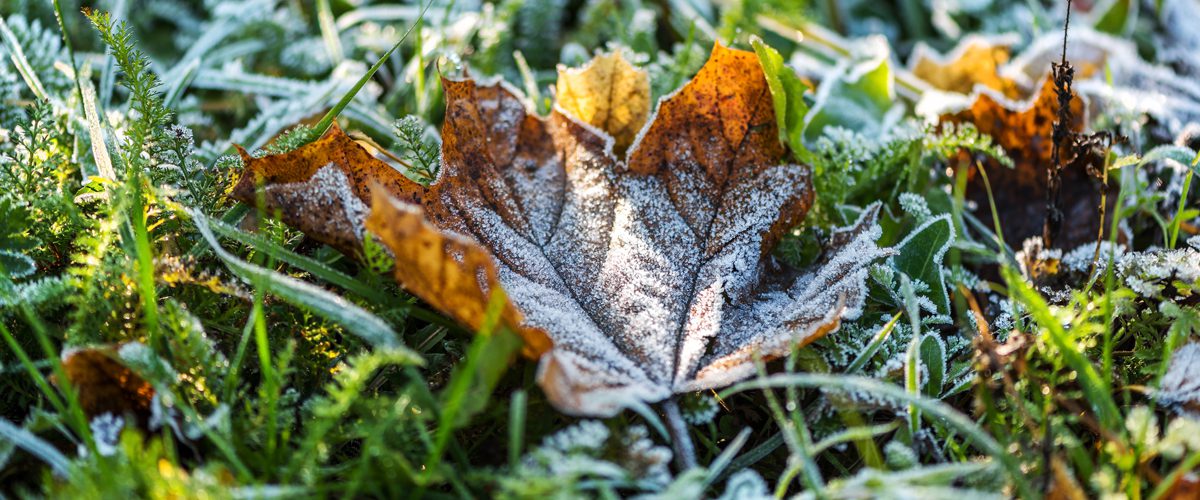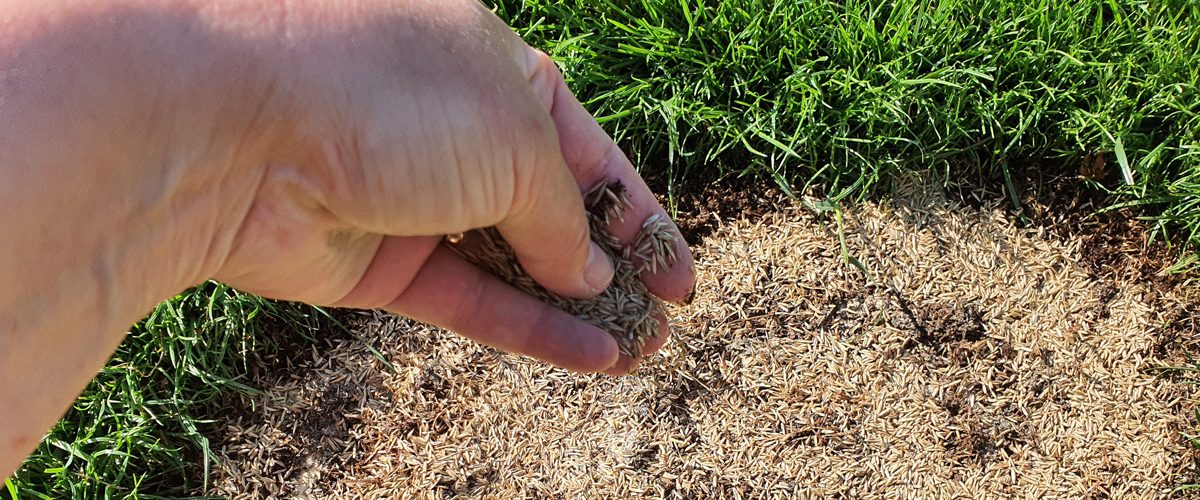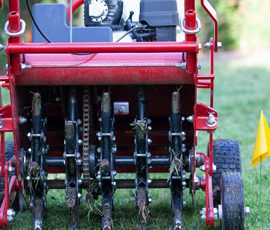
Your lawn still needs care and attention in the winter months if you want it to grow back strong and healthy in the spring. There are so several steps you can take to make sure your lawn has enough nutrients for the winter months, and it’s easy to make sure it’s prepared. If you want to know a bit more about getting your lawn ready for the winter, keep reading to see the top 8 winter lawn tips to help you prepare for the season.
These winter lawn tips will help you make sure that your lawn can survive the cold Canadian winters. You want to see a sea of fresh green grass when the snow melts instead of a patchy and wet mess, and that takes some preparation. Use as many of these great lawn care tips in winter as you need to ensure it stays healthy all winter long.
1) Start in the Fall
Winter starts at different times of the year for different areas, and it can be hard to figure out when you need to start getting your lawn ready for the colder months. You want to make sure you are getting to the ground before it freezes, so start doing your winter preparation during the fall. The first thing you should do is look for any significant issues that might need to be taken care of. If you have spots in your yard that are too damp or too sparse, now is the best time to try to fix them.
You should take note of the things you might need to do and figure out a timeline to make sure you are getting it all finished before the winter hits. Walk around your yard and check out what areas might need some extra help so you can get your supplies ready in time. You want to make sure you aren’t rushing everything and give yourself ample time to spread out the treatments your lawn might need, as some lawn care works best if it’s done after others have been completed.

2) Clear Out the Debris
Your lawn will likely be covered in leaves, branches, plus other debris by the time fall is over, and you have a few options when it comes to handling it. Many people choose to sweep up their leaves so that they can let the lawn breathe and prevent thatch from forming. Removing the leaves can also help allow more sun onto your lawn and prevent yellow spots from forming.
While raking might help your lawn in some way, there are other ways you can deal with your leaves that can make your yard much healthier. Many people have started to mulch their leaves by using their mower, which will break the leaves up into smaller pieces and prevent any major issues that come along with too much leaf coverage. The mulched leaves will also bring earthworms into your lawn, which will give your whole lawn a dose of extra nutrients.
3) Tidy Up the Yard
Moving natural debris out of the way is important, but you also need to ensure you are getting rid of anything else that might be blocking the grass. Many people have children who love to play outside as much as possible, which means your yard ends up looking like a Toys R Us exploded. If these outdoor toys end up sitting on your lawn all winter, your grass will take a big hit, and it won’t be able to thrive as it should.
You should go over your yard and put away everything that doesn’t need to be placed on the lawn. Things like pet toys, lawn equipment and gardening tools should be cleared out and put back in their proper spot before the winter hits. If you have quite a bit, look into buying a small storage shed so that you have a convenient place to put it all away.
4) Aerate the Tough Spots
Your lawn can quickly become compacted by lots of foot traffic, damp areas to a buildup of dry grasses. This grass and mud buildup is commonly referred to as thatch, and it can be difficult to remove unless you know what you’re doing. To test and see if your lawn is having an issue with thatch, try to plunge a screwdriver into the soil and see how far it reaches. If it doesn’t hit the handle, you have an issue, and you will need to aerate before your lawn can start to repair itself.
To break through the thatch, you need to aerate your lawn. There are a few different ways you can do this, but using an aeration tool like a roller is the most common. These rollers poke holes in the soil, which breaks up the thatch naturally and allows the extra water to flow down into the roots. The holes also allow for seeds to implant much easier, which means they will work much faster on your lawn.

5) Overseed as You Need
Overseeding is one of the best ways to repair areas that have major damage. If you have a spot that has been damaged by pet urine, heavy traffic, or lack of sun, you should make sure you focus on these areas first. The best way to overseed is by spreading the seed lengthwise and widthwise over the area to ensure it gets the right amount of coverage.
Overseeding after you have aerated is the best way to ensure the seeds will be going deep into the ground and sprouting their roots. You should also make sure you are buying the correct seed for your lawn. If you are growing a specific type of grass, make sure to match the seeds, or the lawn will look uneven. You should also make sure you are using a seed that works with your climate and weather, instead of choosing a basic overall seed that might not grow as well.
6) Feed Your Lawn
Fertilizer will work best if you make two separate applications during the fall. One application at the beginning of fall and one at the end will help your lawn have all the nutrients and vitamins it will need to sustain itself over the winter. It’s a good idea to make sure you are getting the best formula for your lawn in order to test your soil using a pH kit to determine what formulation will work the best.
Most fertilizers will give you the amount of nitrogen, phosphorus, and potassium they contain, so you can select one to help with the nutrients your lawn lacks. It’s often given in an N-P-K format on the bag with numbers representing the amount of each nutrient (5-10-5, for example) which makes it easy to figure out the right one. Your pH test will show whether your soil is too acidic or too alkaline, and you can decide to add extra additives such as peat moss (to bring down your pH level) or lime (to bring it up) to keep your soil in a neutral state.
7) Cut it at the Right Height
Your mower is adjustable for a reason, and you want to make sure you’re not cutting too much off in the colder months. You also want to make sure that the grass isn’t too long before it’s covered in snow. The longer your grass is, the better the root will be, so it’s a good idea to cut your lawn with your blade raised up before the winter season hits.
If you grass it too long, it won’t be able to equally distribute the excess moisture that the snow is creating. This can cause your lawn to develop thatch over the winter, and it can also make it susceptible to mold. A moldy lawn is difficult to control, especially in the spring, so you need to make sure you are doing everything you can to reduce the chances.

8) Winterize Your Irrigation System
If you have an irrigation system that helps keep your lawn healthy, then you should know how to get it to shut down for the wintertime. It’s important to know how to properly drain the water from the system; otherwise, you are risking a major issue with breakage if the water in your system freezes. Freezing water can cause damage to the lines and the sprinkler heads, so if you want your system to last a long time, you need to know how to maintain it properly.
Winterizing your system usually means you are clearing out the excess water using an air compressor with adequate pressure. If you don’t know how to shut down your system properly, or you are worried about damaging your equipment, you should contact a local irrigation expert to help you out. They will be able to assess your system and use their equipment to make sure there isn’t any water left in the system when the cold weather hits.
Getting your lawn ready for winter is easy if you know all the steps to take, and it’s the best way to make sure you don’t have to do much maintenance when springtime comes. Winter can be harsh on your lawn, and it’s a good idea to make sure you are as knowledgeable as you can be when it comes to winter lawn care tips. It’s easy for issues to arise if the yard isn’t properly cared for, so do the best you can to make sure it’s ready to experience the cold temperatures that are likely to hit.



